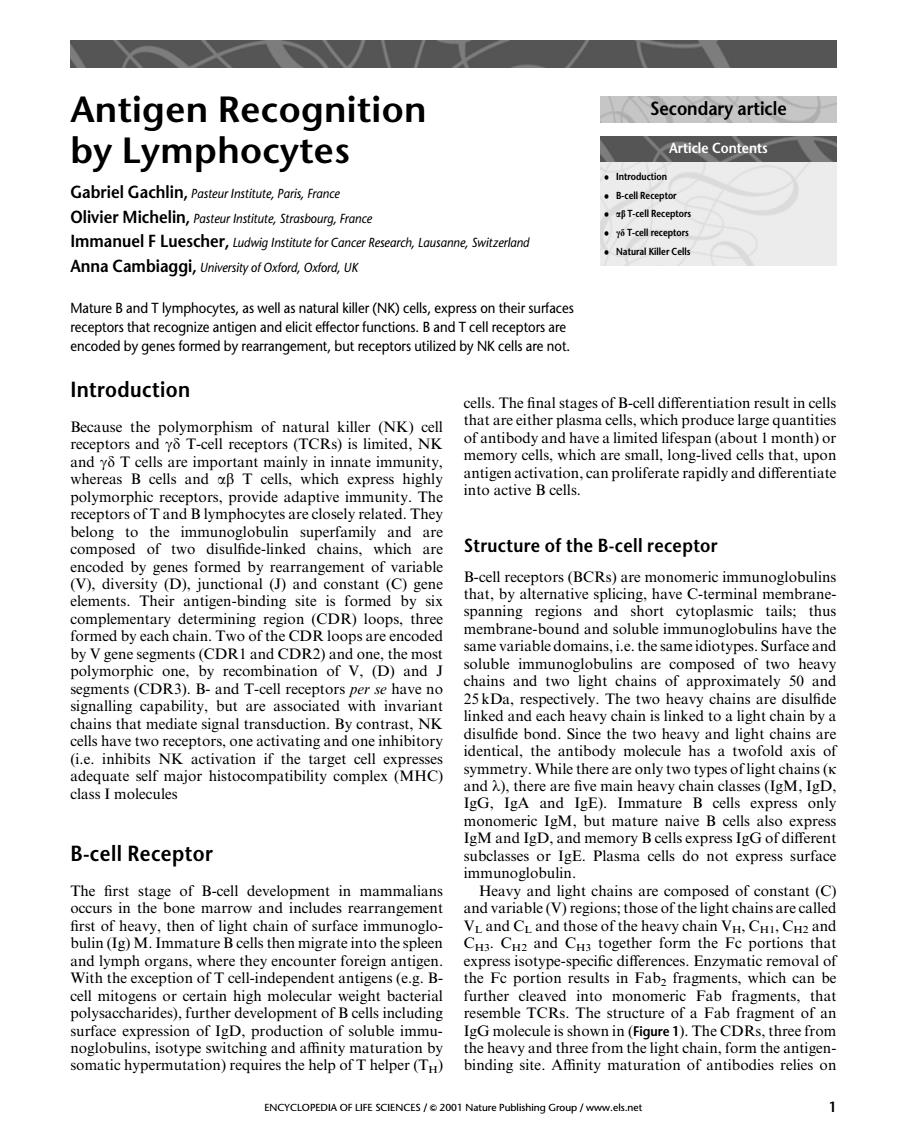正在加载图片...

Antigen Recognition Secondary article by Lymphocytes Artice Contents Gabriel Gachlin,Pasteur Institute Paris,France ·B-cell Receptor Olivier Michelin,Pasteur Institute Strasbourg,Franc .T-cell Recepto Immanuel FLuescher,Ludwig Institute for Cancer Research,Lousanne,Switzerland o T-cell rece Anna Cambiaggi,University of Oxford,Oxford,UK Introduction GmaTteepaemoeeoieoargtine ells the final stag ntiation result in cells nemory cells. nall,long-lived cell at,upon oenCBain.canpolifcraterapidyanddicerentiate polymorphic receptors,provide adaptive immunity.The the Structure of the B-cell receptor encoded by ge es formed by rearrangement of variable (V).diversity (D),junctional (J)and constant(C)gene B-cell rece unoglobulins elements.Their antigen-binding site formed by six spanning regions and s ort tails;thus an by V gene segments (CDRI and CDR2)and one.the mos polymorphic one,by recombination of V,(D)and J soluble immunoglobulins are co posed of two heav segments(CDR3).B-and T-cell rec hains and two light chains of approximately 50 and have no 5kDa,respec are hain bya identical.the antibody molccule has a twofold axis of symmetry.While there are only two types oflight chains(k ere are five main heavy ch in cl lasses(IgM,IgD press onl IgM and IeD.and memory B cells express IgG of difterent B-cell Receptor subclasses or IgE.Plasma cells do not express surface mmunoglobuli chai first of hea then of light chain of surface immu VL and CL and those of the heavy chain VH.CHL.CH2 and bulin(Ig)M.Immature Bcells then migrate into the spleen CH3.Cu2 and CH3 together form the Fc portions that ences.Enzymat nt antg ens (e.g. rton results s in Fab2 ell mito th polysaccharides).further development of B cells including esemble TCRs.The structure of a Fab fragment of an surface expression of IgD,production of soluble immu gG molecule is shown in(Figure 1).The CDRs,three from relies on ENCYCLOPEDIA OF LIFE SCIENCES/2001 Nature Publishing Group/www.els.net 1 Antigen Recognition by Lymphocytes Gabriel Gachlin, Pasteur Institute, Paris, France Olivier Michelin, Pasteur Institute, Strasbourg, France Immanuel F Luescher, Ludwig Institute for Cancer Research, Lausanne, Switzerland Anna Cambiaggi, University of Oxford, Oxford, UK Mature B and T lymphocytes, as well as natural killer (NK) cells, express on their surfaces receptors that recognize antigen and elicit effector functions. B and T cell receptors are encoded by genes formed by rearrangement, but receptors utilized by NK cells are not. Introduction Because the polymorphism of natural killer (NK) cell receptors and gd T-cell receptors (TCRs) is limited, NK and gd T cells are important mainly in innate immunity, whereas B cells and ab T cells, which express highly polymorphic receptors, provide adaptive immunity. The receptors of T and B lymphocytes are closely related. They belong to the immunoglobulin superfamily and are composed of two disulfide-linked chains, which are encoded by genes formed by rearrangement of variable (V), diversity (D), junctional (J) and constant (C) gene elements. Their antigen-binding site is formed by six complementary determining region (CDR) loops, three formed by each chain. Two of the CDR loops are encoded by V gene segments (CDR1 and CDR2) and one, the most polymorphic one, by recombination of V, (D) and J segments (CDR3). B- and T-cell receptors per se have no signalling capability, but are associated with invariant chains that mediate signal transduction. By contrast, NK cells have two receptors, one activating and one inhibitory (i.e. inhibits NK activation if the target cell expresses adequate self major histocompatibility complex (MHC) class I molecules B-cell Receptor The first stage of B-cell development in mammalians occurs in the bone marrow and includes rearrangement first of heavy, then of light chain of surface immunoglobulin (Ig) M. Immature B cells then migrate into the spleen and lymph organs, where they encounter foreign antigen. With the exception of T cell-independent antigens (e.g. Bcell mitogens or certain high molecular weight bacterial polysaccharides), further development of B cells including surface expression of IgD, production of soluble immunoglobulins, isotype switching and affinity maturation by somatic hypermutation) requires the help of T helper (TH) cells. The final stages of B-cell differentiation result in cells that are either plasma cells, which produce large quantities of antibody and have a limited lifespan (about 1 month) or memory cells, which are small, long-lived cells that, upon antigen activation, can proliferate rapidly and differentiate into active B cells. Structure of the B-cell receptor B-cell receptors (BCRs) are monomeric immunoglobulins that, by alternative splicing, have C-terminal membranespanning regions and short cytoplasmic tails; thus membrane-bound and soluble immunoglobulins have the same variable domains, i.e. the same idiotypes. Surface and soluble immunoglobulins are composed of two heavy chains and two light chains of approximately 50 and 25 kDa, respectively. The two heavy chains are disulfide linked and each heavy chain is linked to a light chain by a disulfide bond. Since the two heavy and light chains are identical, the antibody molecule has a twofold axis of symmetry. While there are only two types of light chains (k and l), there are five main heavy chain classes (IgM, IgD, IgG, IgA and IgE). Immature B cells express only monomeric IgM, but mature naive B cells also express IgM and IgD, and memory B cells express IgG of different subclasses or IgE. Plasma cells do not express surface immunoglobulin. Heavy and light chains are composed of constant (C) and variable (V) regions; those of the light chains are called VL and CL and those of the heavy chain VH, CH1, CH2 and CH3. CH2 and CH3 together form the Fc portions that express isotype-specific differences. Enzymatic removal of the Fc portion results in Fab2 fragments, which can be further cleaved into monomeric Fab fragments, that resemble TCRs. The structure of a Fab fragment of an IgG molecule is shown in (Figure 1). The CDRs, three from the heavy and three from the light chain, form the antigenbinding site. Affinity maturation of antibodies relies on Article Contents Secondary article . Introduction . B-cell Receptor . ab T-cell Receptors . cd T-cell receptors . Natural Killer Cells ENCYCLOPEDIA OF LIFE SCIENCES / & 2001 Nature Publishing Group / www.els.net 1